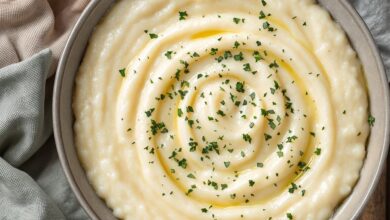Is Cloud Bread OK for Diabetics? Find Out Here

If you’re managing diabetes, you might be wondering: Is Cloud Bread OK for Diabetics? It’s become a popular low-carb bread substitute, but how does it affect blood sugar levels? The short answer is yes—when made without added sugars, cloud bread is a blood sugar-friendly option that fits well into a diabetic diet. However, as with any food, portion control and ingredient choices are key. Let’s explore why this fluffy, low-carb bread alternative is worth considering.
What is Cloud Bread?
Cloud bread has become one of the most talked-about low-carb alternatives in recent years. It’s light, fluffy, and has a texture that sets it apart from regular bread. Originally popularized in low-carb and gluten-free diets, it’s now making waves in the health-conscious community for its simplicity and versatility. But what exactly goes into cloud bread, and how can you make it yourself? Let’s take a closer look.
Ingredients of Cloud Bread
One of the reasons cloud bread is gaining popularity among those with diabetes is its simplicity. The recipe calls for only a handful of ingredients, which are typically low-carb and free of common allergens like gluten. Here’s what you’ll most commonly find in a traditional cloud bread recipe:
- Eggs: The primary ingredient providing structure, fluffiness, and protein.
- Cream Cheese: Offers a creamy texture and slight tanginess. Some recipes swap this for cottage cheese or mascarpone.
- Cream of Tartar: Helps stabilize the egg whites, creating that signature airy texture.
- Optional Sweetener or Seasoning: Depending on whether you want a savory or sweet version. For sweet options, avoid sugar and opt for a diabetes-friendly substitute like stevia.
These ingredients are high in protein and low in carbohydrates, making cloud bread an excellent option for those monitoring their blood sugar levels. However, it’s crucial to check the nutritional label on any optional ingredients, like cheese or seasonings, to ensure there’s no added sugar.
For further information on diabetes-friendly bread alternatives, explore this comprehensive guide at health100.org.
How to Make Cloud Bread
Making cloud bread is incredibly straightforward and requires just a mixing bowl, a whisk, and a baking sheet. Here’s a quick step-by-step guide to help you get started:
- Preheat Your Oven: Set it to 300°F (150°C) and line a baking sheet with parchment paper.
- Separate Egg Whites and Yolks: Use three large eggs. Keep the whites and yolks in separate bowls.
- Whip Egg Whites: Add ¼ teaspoon of cream of tartar into the egg whites. Beat them with an electric whisk until stiff peaks form.
- Mix Egg Yolks: In a separate bowl, blend the yolks with 3 tablespoons of softened cream cheese or mascarpone until smooth.
- Combine Gently: Fold the whipped egg whites into the yolk mixture carefully. Avoid over-mixing to keep the batter airy.
- Scoop and Shape: Spoon the mixture onto the prepared baking sheet, creating small rounds or larger bread shapes.
- Bake: Place the tray in the oven and bake for about 25 minutes or until golden on top.
- Cool & Serve: Let the bread cool before removing it from the baking sheet.
Looking for more cloud bread recipe inspiration? Check out the Easy Cloud Bread Recipe from AllRecipes for another take on this fluffy delight.
Cloud bread is great for sandwiches, mini pizza bases, or even as a snack on its own. It’s a versatile choice whether you’re managing diabetes or simply trying to reduce your carb intake.

Photo by Alexy Almond
Stay tuned for more insights into how cloud bread fits into a diabetic-friendly diet.
Nutritional Profile of Cloud Bread
Cloud bread offers a unique nutritional profile compared to conventional bread, making it a popular choice for individuals managing diabetes. Unlike typical carb-heavy loaves, cloud bread leans on low-carb ingredients, such as eggs and cream cheese, to provide a lighter and more blood sugar-friendly alternative. Let’s take a closer look at its macronutrient composition.
Carbohydrate Content
Traditional bread often contains significant amounts of carbohydrates, which can spike blood sugar levels. Cloud bread, however, flips the script. Most recipes consist of almost zero grams of carbohydrates per slice, making it an excellent bread substitute for diabetics aiming to control blood sugar levels.
- Why is this important? Carbohydrates play a big role in how quickly your blood sugar rises. Low-carb alternatives like cloud bread are gentle on glucose levels because they lack starches and sugars that cause abrupt spikes.
- For instance, commercially available cloud bread often boasts <1 gram of carbs per serving. Check out the nutrition facts on Cloud Bread by Cloudies for an example of how low-carb this substitute can be.
Choosing cloud bread over standard bread can make sticking to a low-carb diet easier. However, be cautious with toppings or spreads that may add hidden sugars.
Protein and Fat Aspects
Cloud bread derives most of its calories from protein and fat, two macronutrients essential for individuals managing diabetes.
Protein content: A single slice of cloud bread typically contains about 4–7 grams of protein, depending on the recipe. Protein slows digestion, which helps stabilize blood sugar after meals. By incorporating this bread into your diet, you can pair it with various protein-rich toppings like turkey or avocado for a balanced snack. Learn more about how protein supports blood sugar control at Beachbody.
Fat Content: Cloud bread’s fat content stems largely from ingredients like cream cheese or butter. Each slice typically contains around 6–9 grams of fat. While fat does not directly affect blood glucose levels, its presence delays carbohydrate digestion, leading to steadier blood sugar control. Those following low-carb, high-fat regimens like keto may find cloud bread fits neatly into their lifestyle.
- For context, 100 grams of cloud bread contains approximately 9.3 grams of fat and 7.48 grams of protein, according to Fat Secret.
By combining protein and fat in one convenient package, cloud bread can keep you feeling fuller longer, helping to prevent those mid-day hunger spikes that may lead to poor food choices. However, moderation is key—overdoing high-fat foods can impact heart health over time.
Is Cloud Bread Safe for Diabetics?
If you’ve been curious about incorporating cloud bread into a diabetes-friendly diet, you’re not alone. This low-carb, fluffy bread alternative has sparked interest among those managing blood sugar levels. Let’s explore its impact on health and diabetes management.
Glycemic Index Considerations
When managing diabetes, the glycemic index (GI) of foods is vital. The GI measures how quickly a food raises blood sugar levels on a scale from 0 to 100. Foods with a lower GI (below 55) have a gentler effect on glucose levels compared to high-GI foods.
Cloud bread naturally has a very low GI due to its minimal carb content. Since it contains virtually no flour or starch—the culprits behind high-GI foods—it doesn’t cause the rapid blood sugar spikes commonly associated with traditional bread. This makes it a popular substitute among people on a low-carb diet.
However, it’s important to note that while cloud bread itself may have a low glycemic impact, the toppings or spreads you use can significantly alter its effect. Stick with diabetes-friendly options like avocado, unsweetened nut butter, or lean proteins for best results.
For other great low-GI recipes, check out Are Grits Good for Diabetics? for additional ideas.

Photo by Artem Podrez
Expert Opinions on Cloud Bread
Medical professionals and nutritionists often highlight the benefits of low-carb diets for managing diabetes. Cloud bread—a staple in such diets—has gained recognition for its role in blood sugar control. According to nutritionist insights shared in The Healthy, cloud bread lacks carbohydrates that spike glucose, but also fiber, which stabilizes blood sugar.
While most experts agree that cloud bread is generally safe for diabetics, ingredient quality and preparation methods are key. Opt for recipes that avoid added sugars or high-fat cheeses, sticking with simple, whole ingredients.
For those seeking online community perspectives, visit the Diabetes Forum’s Cloud Bread resources. Users share tips, cautions, and recipe adaptations tailored to diabetic needs.
Potential Health Benefits
Cloud bread brings several health perks to the table, particularly for those managing diabetes:
- Blood Sugar Control: With its low-carb base, cloud bread helps prevent abrupt spikes in glucose following meals.
- High in Protein: Eggs, a primary ingredient, supply a good dose of protein, which helps stabilize blood sugar by slowing digestion.
- Satiation: The combination of fat and protein keeps you full longer, reducing hunger-related overeating.
- Gluten-Free: Since it doesn’t rely on flour, it’s safe for individuals with gluten sensitivities who are also managing diabetes.
Cloud bread also supports the latest dietary trends, like keto or low-carb eating, making it easier to meet both lifestyle and medical goals. For recipe suggestions, explore this Zero Carb Bread Recipe and try adding your favorite diabetic-friendly toppings.
By combining great taste with a blood sugar-friendly nutritional profile, cloud bread remains a valuable option for diabetics looking to diversify their meal options without compromising health.
How to Incorporate Cloud Bread into a Diabetic Diet
Cloud bread is a versatile, low-carb option loved by many on a diabetic-friendly diet. Its light texture and adaptability make it a great alternative to traditional bread, but there’s more to enjoying it than just swapping it into your meals. Let’s explore how you can maximize its benefits by pairing it wisely and incorporating it into your meals.
Pairing Cloud Bread with Healthy Foods
To make the most of cloud bread on a diabetic diet, choosing the right toppings and sides is essential. Since cloud bread itself contains minimal carbs, the focus shifts to what you put on or serve alongside it. Here are some healthy and diabetes-friendly pairings:
- Avocado Slices: Rich in heart-healthy fats and fiber, avocado adds creaminess and nutrients without causing blood sugar spikes.
- Nut Butter: Opt for unsweetened almond or peanut butter to boost protein and healthy fats. Check portion sizes to avoid excessive calories.
- Lean Proteins: Think turkey, grilled chicken, or smoked salmon. These can create a satisfying sandwich or open-faced toast.
- Vegetable-Based Spreads: Use hummus or guacamole for a savory, low-carb topping full of flavor and nutrition.
- Eggs: Scrambled, fried, or poached eggs on cloud bread make for a simple, protein-packed breakfast option.
- Low-GI Fruits: Add fresh berries for a touch of natural sweetness. They pair well with cream cheese or mascarpone-based spread.
By pairing smartly, cloud bread becomes more than just a replacement—it’s a tool to help balance your blood sugar while keeping meals exciting.
Meal Ideas Featuring Cloud Bread
Cloud bread is more than a side dish—it shines as the centerpiece of creative, low-carb meals. Here are a few ideas to elevate your diabetic diet:
- Breakfast Sandwich: Layer a slice of cloud bread with scrambled eggs, turkey bacon, and spinach for a balanced start to your morning. The combination of protein and fiber will keep you feeling full and steady.
- Mini Pizzas: Use cloud bread as a base, add sugar-free marinara, low-fat mozzarella, and your favorite veggies. Bake until bubbly for a low-carb pizza night.
- Lunch Wrap Substitute: Create a low-carb “wrap” by doubling up slices of cloud bread. Fill with grilled chicken, greens, and some avocado. A perfect grab-and-go meal!
- Snack Bites: Spread cream cheese or unsweetened nut butter on smaller cloud bread rounds, topped with a sprinkle of cinnamon or chia seeds for a quick, balanced snack.
- Open-Faced Burgers: Replace buns with cloud bread when making burgers. Add lettuce, tomato, and a lean patty for a hearty-yet-healthy dinner.
For more diabetes-friendly recipes, explore these delicious low-carb ideas.
These meal ideas show how cloud bread can integrate into a variety of cuisines and dietary preferences, all while being easy on your blood sugar. Don’t be afraid to experiment and make it your own! Want to tweak the recipe? Check out this easy mascarpone cloud bread recipe to get started.
Key Takeaways
For individuals managing diabetes, cloud bread can be a great alternative to traditional bread. It’s low-carb, high-protein, and versatile enough to fit smoothly into a diabetes-friendly diet. Below are the key points to keep in mind when considering cloud bread as part of your meals.
Low-Carb Benefits for Blood Sugar Control
Cloud bread’s standout feature is its minimal carbohydrate content. Unlike traditional bread that can cause blood sugar spikes, cloud bread provides a low-glycemic option. It’s especially effective for managing blood sugar levels when paired with diabetes-friendly toppings or sides.
- Most recipes offer less than 1 gram of carbohydrates per serving.
- Its carb-free nature makes it ideal for those monitoring glucose levels.
For a recipe that highlights these benefits, you can explore the Zero Carb Bread Recipe.
Nutritional Highlights
Cloud bread isn’t just low in carbs. Its high protein and moderate fat contents provide essential nutrients that help stabilize blood sugar levels and promote satiety.
- Protein Content: Each slice contains roughly 4–7 grams of protein, depending on the recipe.
- Healthy Fats: Ingredients like cream cheese add around 6–9 grams of fat per slice, supporting longer-lasting energy.
Quick tip: Pair it with lean proteins or healthy fats like avocado or nut butter for a balanced bite. Check out more ideas for cloud bread uses.
Easy to Customize
Whether you prefer savory or sweet, cloud bread offers versatility in both flavor and usage:
- Add a sprinkle of cinnamon and stevia for a low-sugar dessert option.
- Create savory sandwiches with ingredients like turkey and spinach.
If you’re ready to try your hand at making cloud bread, refer to this simplified recipe for step-by-step instructions.
Diabetes-Friendly Pairings Matter
While cloud bread itself is diabetic-friendly, what you pair with it is equally important. Stick to low-GI toppings like:
- Avocado
- Lean proteins (e.g., grilled chicken or turkey)
- Unsweetened nut butter
For more tips on pairing foods, visit the Diabetes Forum’s discussion on cloud bread.
By understanding these key takeaways, you can better decide if cloud bread aligns with your dietary needs. Keep experimenting with toppings and meals to make it a staple in your diabetes management plan!
Conclusion: Is Cloud Bread OK for Diabetics?
Cloud bread stands out as a low-carb, blood sugar-friendly option for diabetics when made with the right ingredients. Its minimal carbohydrate content, combined with protein and healthy fats, makes it a versatile substitute for traditional bread. Pair it with diabetes-friendly toppings like avocado, lean proteins, or unsweetened nut butter to maximize its benefits.
Experimenting with cloud bread can add variety to your meals without compromising blood sugar control. For more ideas on how to stay on track with a low-carb diet, check out diabetes-friendly tips and recipes.
Ready to give cloud bread a try? Try incorporating it into your next meal and see how it fits into your dietary goals!




